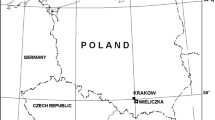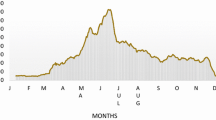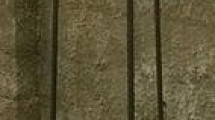Abstract
Caves and mines have a suitable microclimate in terms of temperature, humidity and air purity that could be exploited for speleotherapy. The aim of this study was to evaluate the current load of allergenic airborne bioparticles of a subterranean environment being considered as a potential site for treating respiratory allergies. Sampling was performed over 12 months (2015–2016) inside and outside the Sant'Aloisio mine by: (i) continuous aerobiological sampling with Hirst-type samplers and (ii) monthly air sampling with an on-plate volumetric sampler using three different selective culture media. The following protocols were applied for the two methodologies: (i) Samples were processed following the European standard (UNI CEN/TS 16868:2015) and analyzed by light microscopy to identify and count pollen grains and fungal spores; (ii) plates were incubated, colony-forming units (CFU) were counted and concentration of CFU was calculated. Spore and pollen load, as evaluated by the continuous monitoring, resulted in very low values inside the mine, with a total of 106 pollen grains and 41 fungal spores from two species (Alternaria and Cladosporium) collected over the entire year; the pollen and spore concentration in the subterranean environment was negligible when compared to the open-air sampling (0.2% for pollen; 0.02% for spores). Viable airborne microorganisms were less represented in the mine than in the open air (median: 7 and 83 CFU*m−3, respectively). The indoor air of the disused mine was confirmed to be suitable for hosting respiratory disease sufferers from an aerobiological point of view. The residual low quantity of pollen grains could be the result of unintentional human transport. The indoor fungal component of the viable airborne microorganisms was mostly derived from non-allergenic wood-decaying fungi.
Similar content being viewed by others
Avoid common mistakes on your manuscript.
1 Introduction
Allergic diseases are a global public health problem, with an increase in the prevalence of asthma and rhinitis being noted worldwide (World Allergy Organization 2013). The pharmaceutical treatment of chronic respiratory diseases can be complemented by ‘natural’ methods, such as balneology. Speleotherapy, in particular, takes advantage of the microclimate of caves and mines; short stays in an allergen-free, steady-temperature and high-humidity environment have been proven to provide relief from symptoms (Kostrzon et al. 2015; Munteanu 2017).
Up to now, the most studied subterranean environments are the salt mine health resorts of the sub-Carpathian region, where radon (Calin et al. 2012a, b; Kertesz et al. 1999), air ions (Roubal et al. 2017), bacteria and fungi (Fraczek et al. 2013; Fraczek and Kozdroj 2013) and allergens and pollen (Myszkowska et al. 2019) have been surveyed.
The aim of this study was to evaluate the current load of allergenic airborne bioparticles (mainly pollen grains and fungal spores) of the indoor environment of a disused siderite mine, in order to define the suitability of this subterranean environment for hosting a climatic therapy for sufferers of respiratory diseases. The study was performed prior to the construction of the speleotherapy center.
2 Materials and methods
2.1 Study site
The study site was the disused siderite mine of Sant’Aloisio, Brescia, Italy, located in the Trompia Valley, at an elevation of 790 m a.s.l. (45°48′11.24″N, 10°19′16.20″E). Climate is defined as prealpine temperate, with a reduced oceanic footprint, of the cold axeric region. Surrounding vegetation is characterized by mesophilic deciduous woodland in the valley floor, maple–ash and maple–linden formations on the slopes, virtually unmodified by anthropogenic activities.
2.2 Study design
For 12 months from June 2015 to June 2016, one Hirst-type trap working continuously at a rate of 10 l*min−1 suction volume was installed on the terrace of the main building (‘outdoor site’) and another 900 m from the entrance inside the mine (‘indoor site’), both at the same elevation.
Once a month, from July 2015 to June 2016, on-plate volumetric sampling with an SAS Super 100 air sampler with 500 l of suction volume per sample (5 min at 100 l*min−1) (International PBI, Milan, Italy) was performed to collect viable microorganisms on three different culture media, with three replicates each (Pasquarella et al. 2010). Culture media were selected to grow different targets: (i) plate count agar (PCA; Lab M Limited, Heywood, UK) for all viable microorganisms (composite origin), (ii) PCA with chloramphenicol 0.01% for fungi and yeasts and (iii) PCA with cycloheximide 0.005% for bacteria.
From September 2015 to June 2016, temperature (T) and relative humidity (RH) were measured every 15 min at each sampling site with data loggers (TGU-4500, Gemini Data Loggers Ltd., Chichester, UK).
2.3 Airborne biological particle analysis
Aerobiological samples obtained from the Hirst-type traps were processed following the European Technical Sheet (UNI CEN/TS 16868:2015). Sampled tape was collected every week, cut into daily subsamples, stained with basic fuchsin, mounted on slides and analyzed by light microscopy at 400× magnification, using as references the slide collection of pollen grains at Fondazione Edmund Mach, as well as a pollen atlas (http://pollini.iasma.it/polimage; Bucher et al. 2004) and pollen identification keys (Faegri and Iversen 1989). Pollen grains and Alternaria and Cladosporium spores were identified and counted on four longitudinal sweeps (14% of the surface), and the daily concentration in pollen grains (or spores)*m−3 was calculated for each day throughout the sampling year.
Overall, 13 samples for the viable microorganisms were collected both outdoor and indoor (26 in total), one per month except December 2015, when two samples were taken. Petri dishes from the monthly sampling of the viable microorganism were incubated at 30 °C, and colony-forming units (CFUs) were counted daily. The number of colonies reached a plateau after six days, and thus, analyzed data refer to the concentration of CFUs per cubic meter calculated on the number of CFUs at day 6 after sampling (Myszkowska et al. 2019). The most frequent fungal colonies were isolated and identified by sequence data in combination with phenotypic characters (Identification Service, Westerdijk Fungal Biodiversity Centre, Utrecht, The Netherlands).
Statistical comparison of airborne particle concentrations between the two sites was made using the Mann–Whitney U test (Statistica 13, TIBCO Software Inc.).
3 Results and discussion
3.1 Microclimatic characterization
Air temperature at the indoor site resulted in an average of daily mean of 9.6 °C (range: min 8.6–max 10.4 °C), while at the outdoor site temperatures varied from - 10.6 to + 36.7 °C (mean 6.8 °C; Fig. 1).
Air temperature (a) and relative humidity (b) measured at the sampling sites of the disused siderite mine of Sant’Aloisio, Brescia, Italy, between September 2015 and June 2016. Values recorded inside the mine are represented as red squares (in), while those of the outdoor site as blue diamonds (out)
Mean relative humidity (RH) was high, both outside (88.3%; range 11.2–100%) and inside (99.8%; range 92.1–100%) the mine.
In general, microclimatic conditions in indoor site within the subterranean environment of Sant’Aloisio mine were very stable in terms of both temperature and RH, in agreement with previous results (Kostrzon et al. 2015). Although very few such studies have been performed up to now, in the Wieliczka salt mine (Poland) registered temperature was higher, ranging between 12.9 and 14.5 °C, while the air was drier, with a mean RH of 69% (59.9–74.8%).
3.2 Daily sampling analysis
The analysis of daily samples from the Hirst-type traps revealed very different pollen and spore loads in the indoor compared to outdoor site. While the total pollen concentration along the entire sampling period outside the mine reached 31,674 grains*m−3, a very low concentration was recorded inside, with 106 grains*m−3 as the total load (0.2% of the outdoor pollen load). Temporal variation of total pollen concentration in the outdoor site revealed, as expected, a seasonal trend with pollen emission starting in late January, peaking in April (1946 grains*m−3), while inside the mine the pollen concentration was significantly lower than outside during the entire period (p < 0.01), and very stable, with a maximum daily concentration of 2.9 grains*m−3 (Fig. 2a).
Pollen data analyzed by the daily monitoring of the Hirst-type trap: a temporal variation of the total pollen load, expressed in mean daily concentration (grains*m−3), recorded at the outdoor site (blue diamonds, out) and inside the mine (red squares, in); b pollen spectrum obtained by data collected at the outdoor site, representing the relative load of the ten most abundant taxa
The outdoor pollen spectrum—with the presence of 68 distinct pollen taxa, mainly produced from broadleaved species—reflected the high biodiversity of the local flora. The dominant pollen taxon originated from Ostrya carpinifolia L. (49%), characterized by an exceptional flowering throughout northern Italy in 2016. The same species was responsible for the highest peak value of pollen grains in April, although many other taxa were represented: Corylus sp. (13%), Carpinus betulus L. (5%), Castanea sativa Mill. (4%), Urticaceae (10%), Cupressaceae/Taxaceae (4%), Alnus sp. (3%), Betula sp. (3%), Graminaceae (2%), Fraxinus excelsior L. (2%), Populus sp. (2%) and Fagus sylvatica L. (1%) (Fig. 2b).
Airborne spores collected by the Hirst-type traps revealed a total concentration of 1300 Alternaria spores*m−3 and 148,844 Cladosporium spores*m−3 at the outdoor site, while inside the mine, 11 Alternaria spores*m−3 and 30 Cladosporium spores*m−3 were surveyed over the entire sampling period. Airborne spores at the outdoor site had the highest values during summer (2015), with a peak of 5859 spores*m−3 (2 August 2015), while inside the mine values were stable and low, with a maximum of 4.9 spores*m−3; on 83% of the days, the traps collected no spores at the indoor site (p < 0.01).
3.3 Viable microorganism analysis
Airborne viable microorganisms sampled by SAS were less represented in the indoor site than in the outdoor one, with median values of the total component grown on PCA of 7 and 83 CFU*m−3, respectively (Fig. 3). The difference between the indoor and outdoor sites was statistically significant when the only fungi and yeasts grown on PCA plus chloramphenicol (1 and 41 CFU*m−3; exact p value < 0.001) or bacteria grown on PCA plus cycloheximide (2 and 8 CFU*m−3; exact p value = 0.01) were observed.
Results of the concentration (CFU*m−3) of airborne viable microorganisms collected on-plate outside (out) and inside (in) the mine and cultured on three different media: PCA, PCA plus chloramphenicol (PCA + ch) or cycloheximide (PCA + cy). The box plot indicates the median, and the 25th and 75th percentiles; vertical line represents maximum and minimum values
Lower concentrations of all examined fractions of viable microorganisms were found in the indoor compared to the outdoor site, in agreement with previous studies in Polish salt mines (Fraczek and Kozdroj 2013), where overall indoor concentrations averaged in 20 CFU*m−3.
When excluding bacteria, levels of viable microorganisms were stable and low at the indoor site, while outdoors there was a seasonal pattern, with lower loads of fungi and yeasts during winter.
The most frequent fungal colonies resulted in non-allergenic strains of basidiomycetes (Levetin et al. 2016): Sistotrema brinkmannii (Bres.) J. Erikss Heterobasidion annosum (Fr.) Bref., Heterobasidion parviporum Niemelä & Korhonen and Rigidoporus vitreus (Pers.) Donk. The identified species belong to lignicolous fungi, plant pathogens or saprophytes on dead, decayed wood. Given the paucity of bacterial colonies, we did not analyze their taxonomy.
4 Conclusions
This study carried out at the disused Sant’Aloisio mine over a one-year period demonstrated that the indoor occurrence of allergenic pollen and spores was consistently rare and often completely absent. The main indoor viable airborne microorganisms were represented by non-allergenic wood-decaying fungi, derived from decomposing wood. In addition, microclimatic variables at the indoor site were constant and independent of the outdoor seasonal variations. Both these results confirm that, from an aerobiological point of view, air on the inside of the mine would be suitable for hosting respiratory disease patients (Kostrzon et al. 2015).
Given the rare occurrence of airborne pollens and spores within the mine, possibly transported unintentionally by humans (e.g., mine personnel, visitors), we advise that airborne pollen and spore monitoring be continued after the opening of the speleotherapy center to continuously check the air quality (Fraczek and Gorny 2011). Moreover, in order to preserve the indoor environmental quality, standard procedures minimizing the importation of air contaminants into the mine should be implemented, for example, by asking all personnel, patients and visitors to change into sterile clothes before entering.
References
Bucher, E., Kofler, V., Vorwohl, G., & Zieger, E. (2004). Lo spettro pollinico dei mieli dell’Alto Adige. Bolzano: Laboratorio Biologico, Agenzia Provinciale per l’Ambiente.
Calin, M. R., Calin, M. A., Simionca, G., & Mera, O. (2012a). Indoor radon levels and natural radioactivity in Turda salt mine, Romania. Journal of Radioanalytical and Nuclear Chemistry,292(1), 193–201. https://doi.org/10.1007/s10967-011-1394-2.
Calin, M. R., Zoran, M., & Calin, M. A. (2012b). Radon levels assessment in some Northern Romanian salt mines. Journal of Radioanalytical and Nuclear Chemistry,293(2), 565–572. https://doi.org/10.1007/s10967-012-1686-1.
Faegri, K., & Iversen, J. (1989). Textbook of pollen analysis. London: Wiley.
Fraczek, K., & Gorny, R. L. (2011). Microbial air quality at Szczawnica Sanatorium, Poland. Annals of Agricultural and Environmental Medicine,18(1), 63–71.
Fraczek, K., Gorny, R. L., & Ropek, D. (2013). Bioaerosols of subterraneotherapy chambers at salt mine health resort. Aerobiologia,29(4), 481–493. https://doi.org/10.1007/s10453-013-9298-y.
Fraczek, K., & Kozdroj, J. (2013). Assessment of airborne actinomycetes in subterranean and earth sanatoriums. Ecological Chemistry and Engineering S-Chemia I Inzynieria Ekologiczna, S,20(1), 151–161. https://doi.org/10.2478/eces-2013-0012.
Kertesz, Z., Borbely-Kiss, I., & Hunyadi, I. (1999). Study of aerosols collected in a speleotherapeutic cave situated below Budapest, Hungary. Nuclear Instruments and Methods in Physics Research Section B-Beam Interactions with Materials and Atoms,150(1–4), 384–391. https://doi.org/10.1016/s0168-583x(98)00899-4.
Kostrzon, M., Czarnobilski, K., & Badyda, A. (2015). Climate characteristics of salt chambers used for therapeutic purposes in the ‘Wieliczka’ Salt Mine. Acta Balneologica,1(139), 52–58.
Levetin, E., Horner, W. E., Scott, J. A., Barnes, C., Baxi, S., Chew, G. L., et al. (2016). Taxonomy of allergenic fungi. The Journal of Allergy and Clinical Immunology: In Practice,4(3), 375–385. https://doi.org/10.1016/j.jaip.2015.10.012.
Munteanu, C. (2017). Speleotherapy: scientific relevance in the last five years (2013–2017)–A systematic review. Balneo Research Journal,8(4), 252–254. https://doi.org/10.12680/balneo.2017.161.
Myszkowska, D., Kostrzon, M., Dyga, W., et al. (2019). Bioaerosol of salt chambers in the ‘Wieliczka’ Salt Mine, Poland. Aerobiologia. https://doi.org/10.1007/s10453-019-09561-7.
Pasquarella, C., Veronesi, L., Castiglia, P., Liguori, G., Montagna, M. T., Napoli, C., et al. (2010). Italian multicentre study on microbial environmental contamination in dental clinics: A pilot study. Science of the Total Environment,408(19), 4045–4051. https://doi.org/10.1016/j.scitotenv.2010.05.010.
Roubal, Z., Bartusek, K., Szabo, Z., Drexler, P., & Uberhuberova, J. (2017). Measuring light air ions in a speleotherapeutic cave. Measurement Science Review,17(1), 27–36. https://doi.org/10.1515/msr-2017-0004.
World Allergy Organization. (2013). White book on allergy: Update 2013. Milwaukee: World Allergy Organization.
Acknowledgements
We gratefully thank Maria Cristina Viola for the analysis of daily pollen monitoring slides and laboratory handling and Gianbattista Poli for his technical help in instrument installation and for support in the weekly change of the sampling tape. We are also grateful to the native speakers Heidi Christine Hauffe and Jim Crittenden for their language editing.
Funding
The authors thank Immobiliare Villa Seccamani srl for financial support.
Author information
Authors and Affiliations
Corresponding author
Rights and permissions
About this article
Cite this article
Cristofori, A., Cristofolini, F. & Gottardini, E. Rare occurrence of airborne bioparticles in a speleotherapy site: the case study of the Sant’Aloisio disused siderite mine (Brescia, Italy). Aerobiologia 36, 125–130 (2020). https://doi.org/10.1007/s10453-019-09612-z
Received:
Accepted:
Published:
Issue Date:
DOI: https://doi.org/10.1007/s10453-019-09612-z







